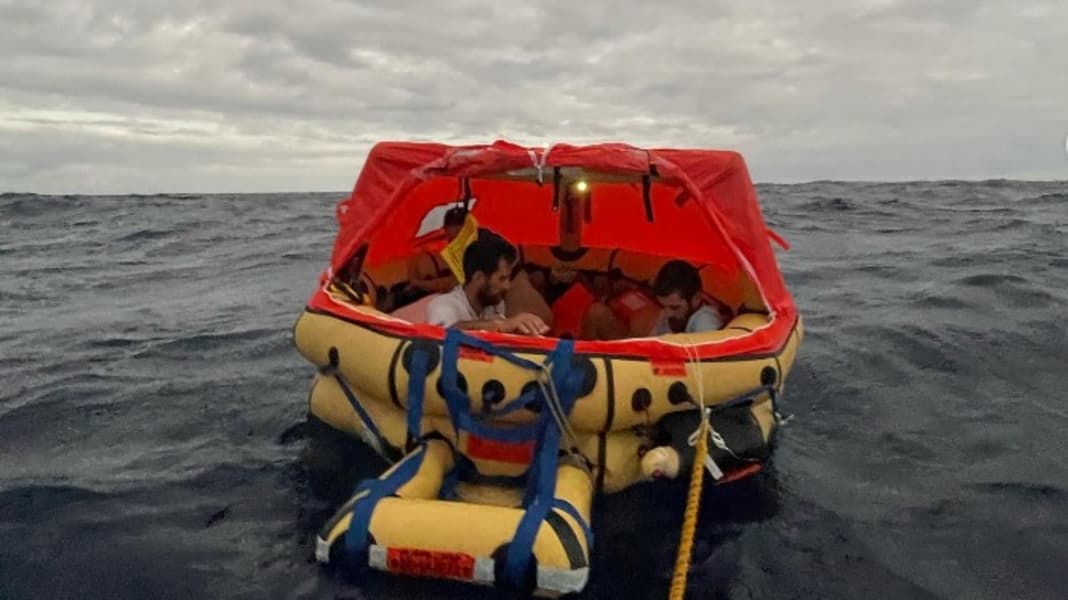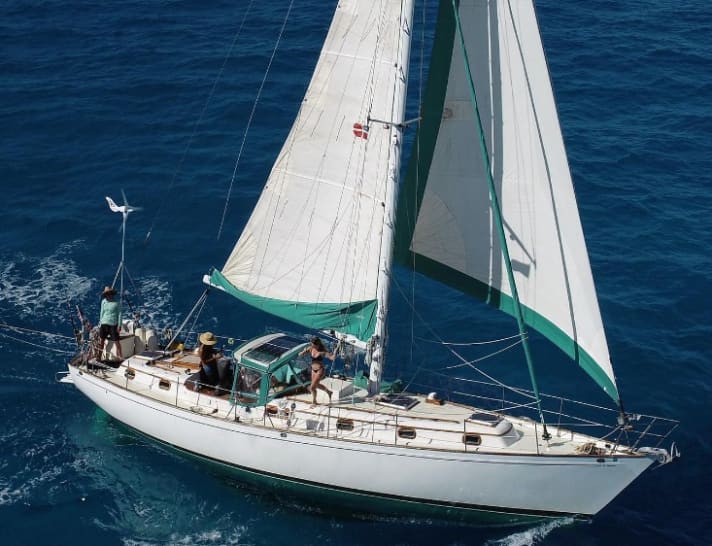
The German Simon Fischer was one of four crew members of the yacht "Raindancer", a 44-foot yacht that was on a blue-water cruise in the Pacific about halfway between Galapagos and French Polynesia when it rammed a whale. In a long, very emotional Instagram video he explains how the dramatic incident came about.
"We were in the cockpit eating pizza when it happened. It's impossible to say whether we hit the whale or it hit us. We sank within 18 minutes, the damage was too massive for us to do anything."
At this point, you will find external content that complements the article. You can display and hide it with a click.
Yacht sinks less than 20 minutes after whale collision
Owner and skipper Rick Rodriguez later said in a report that a crew member saw the whale that the boat had hit dive down. "It was as if we had hit a concrete wall," the boat came to an immediate standstill after previously travelling at six knots. The crew hurriedly checked the boat and the skipper noticed massive water ingress over the propeller shaft and the skeg. The boat was travelling under full sail at the time of the collision.
"After about 30 seconds, we already had the first water on the floorboards," says the skipper. The crew immediately sent out a mayday via VHF, but did not reach any yachts in the vicinity. After the crew had stopped the boat, a quick dive revealed that the boat had massive cracks in the propeller shaft and skeg, which were gaping open centimetres wide, and so much water was pouring into the boat that it was hopeless to try to plug the holes from the inside or outside. The skipper, who had worked as a professional crew on many yachts, then decided that the "Raindancer" could not be saved and that it was now a matter of the crew's survival. The crew immediately began preparations to abandon ship.

Iridium and Starlink crucial for the rescue
"I was looking at my wristwatch, so I can tell you exactly that it took 18 minutes for the boat to sink," says Simon Fischer in his video. But the crew reacted calmly and professionally. The dinghy stored on the foredeck was lowered into the water, the life raft inflated, water, supplies, a radio and an Iridium "GO", a personal AIS and signalling missiles were packed. The skipper hurriedly sent an emergency message via Iridium to his brother and a friend who was sailing about 160 nautical miles behind the "Raindancer", as no contact could be made with other ships via radio.
Then the crew had to get into the dinghy and life raft as the yacht began to sink very quickly. The skipper describes it like this:
"We loaded so much food and water into the life raft and the dinghy until the sink tap in the galley was under water. The foot rail was only a few centimetres above the water. The two women were already in the dinghy and the life raft, waiting for Simon and me. I paused for a moment, thinking about whether there was anything else I could do. Then I took another quick look at the surreal scene. My emotions threatened to overwhelm me for a moment, but then Simon and I climbed into the life raft. (...) I knew that rescue would come soon if I could reach Tommy, 160 miles behind us, or the World ARC fleet. Then I switched off the Iridum to have some battery left for later. When I switched it on again two hours later, I had a whole bunch of answers. It was clear then that everyone was changing course and heading our way."
Freighter is diverted to the castaways
At that point, it was still 1,200 nautical miles to the destination. What the crew didn't realise was that their Epirb had already sounded the alarm and reported the sinking to the Coastguard in the USA, where it was registered. The authorities contacted the MRCC in Peru, but a rescue operation this far out in the Pacific is extremely difficult. Nevertheless, a freighter was diverted to the scene of the accident.
But the crew is lucky: eight boats from the World ARC fleet happen to be sailing very close to the scene of the sinking. The skipper's satellite distress calls spread the news of the sinking via relay call. The "Rolling Stones", a 45-foot cat that is not taking part in the World ARC, ultimately has the shortest distance to the last known position. The crew immediately set off to find the shipwrecked.
Crew safe after 10 hours
Meanwhile, the crew experience their first night in the middle of the Pacific in the life raft. The skipper of the "Raindancer" describes the night like this:
"There we were, drifting in the pitch-black night in a dinghy and a life raft in the middle of the Pacific. We had tied them both together. Flying fish landed in the dinghy all night and the wind picked up. One of us was always on the lookout for ships and we sent out a mayday every hour on our VHF handset. At 5 o'clock in the morning, Simon was the first to see the lights of a ship. After that, we had radio contact with the cat 'Rolling Stones'."
After almost 8 hours, he reaches the position and is able to locate the crew, as Captain Rodriguez has a personal AIS in the life raft and launches a flare. And so, after around 10 hours, the entire crew is safe and sails on to Polynesia on the "Rolling Stone". The organisers of the World ARC have a own report on the rescue operation.
Whale attacks of this kind are no longer a rarity
"We were very lucky that we were rescued so quickly via Iridium and Starlink," says Simon Fischer, who is still visibly shocked by what happened in his Instagram video. He thanked all the helpers for the quick rescue and for the warm welcome on board the Rolling Stones.
The current case of the "Raindancer" is not the first report of its kind. Since 2020, boats have been repeatedly harassed, rammed and, in particular, their rudder blades damaged - mostly sailing yachts up to 15 metres in length. According to official figures, two yachts had previously sunk after similar incidents, but the number of unreported cases is believed to be much higher.
It is currently not known whether this collision also occurred with an orca (killer whale), as in most cases. There have already been several approaches to preventing these attacks. Among other things scattering sand drives the animals away which Latest theory suspects a connection between the incidents and black antifouling.

